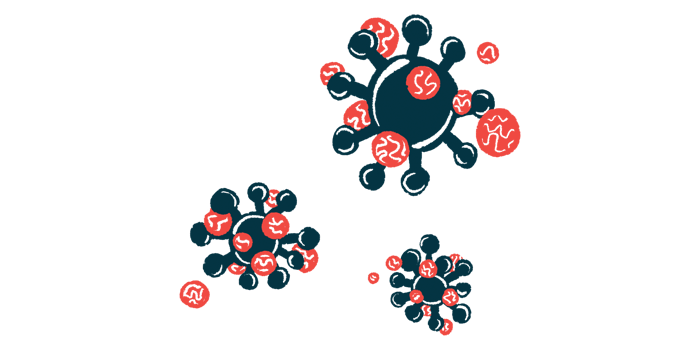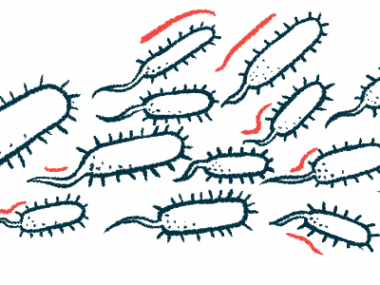COVID-19 complicated blood cancer-associated CAD
Case report describes CAD secondary to lymphoplasmacytic lymphoma
Written by |

Diagnosis and treatment of cold agglutinin disease (CAD) secondary to a type of blood cancer was complicated by COVID-19 in a middle-aged man, a case study reports.
The researchers identified specific mutations in immune cells that may explain the “treatment resistance and susceptibility to COVID-19,” they wrote in the study “Lymphoplasmacytic lymphoma presenting cold agglutinin syndrome: Clonal expansion of KMT2D and IGHV4-34 mutations after COVID-19,” published in the British Journal of Haematology.
In CAD, certain immune B-cells produce self-reactive antibodies called cold agglutinins that bind to red blood cells at cold temperatures. This makes the cells clump together, marking them for destruction (hemolysis).
The disorder is classified as secondary cold agglutinin disease when associated with cancer or infection and as primary CAD in the absence of other known health conditions. There have been some reports of CAD secondary to SARS-CoV-2, the virus that causes COVID-19.
However, “the mechanism underlying [cold agglutinin] production in COVID-19 remains to be elucidated,” the researchers wrote.
Now, researchers at the Fukushima Medical University, in Japan, described the case of a 58-year-old man with CAD secondary to a slow-growing blood cancer that was complicated by SARS-CoV-2 infection.
Due to vision problems in his right eye, the man first visited an ophthalmologist.
Very high levels of immunoglobulin M
Blood tests revealed markedly high levels of immunoglobulin M (IgM) antibodies, the main type of cold agglutinins found in CAD patients.
He also had signs of hemolysis, including below-normal levels of hemoglobin — the protein in red blood cells that carries oxygen — and the haptoglobin protein, whose levels drop when excessive hemoglobin is released into the blood from hemolysis.
He tested positive for cold agglutinins, but there were no signs of antibodies related to infections typically associated with CAD, such as those caused by the Mycoplasma pneumoniae bacterium.
A bone marrow biopsy revealed high numbers of small- to medium-sized lymphocytes, a group of immune cells that include B-cells, and of immature red blood cells with severe clumping.
Based on these and other blood-related findings, the patient was diagnosed with CAD secondary to lymphoplasmacytic lymphoma (LPL), a type of slow-growing blood cancer that develops from abnormal B-cells.
He was started on bendamustine, a chemotherapy used for several blood cancers. After two treatment cycles, his IgM levels were reduced, and he was then given a combination of bendamustine and rituximab, which is commonly used off-label as a first-line therapy in CAD.
Sold as Rituxan in the U.S. and MabThera in Europe, and with generics available, rituximab works by promoting the death of B-cells.
Patient develops COVID-19
During treatment, however, he developed COVID-19 and experienced symptoms of a hemolytic attack, when red blood cells are being destroyed much faster than they are being produced.
He received the anti-COVID-19 medications remdesivir and sotrovimab, and his condition improved without complications.
Despite decreases in both IgM and cancerous B-cells in his bone marrow, the levels of cold agglutinins remained high, and he experienced recurrent hemolytic attacks after COVID-19.
Comparing genetic test results
To investigate further, the team compared genetic test results of DNA extracted from bone marrow cells before and after COVID-19. In cells collected after COVID-19, but not at diagnosis, they detected a mutation in the KMT2D gene, whose mutations have been found in CAD-causing B-cells.
Before and after COVID-19, variants also were found in the IGHV4-34 gene, which provides instructions for a component of cold agglutinins that binds to the surface of red blood cells. Mutations typically associated with LPL were not detected.
Researchers suggested that hard-to-treat abnormal B-cells carrying KMT2D mutations may have grown after COVID-19, while those with IGHV4-34 mutations may have led to hemolysis attacks.
This case “sheds light on the [underlying mechanisms] of LPL with CAS associated with COVID-19,” the researchers wrote.
“Clinicians should exercise caution when treating LPL with [secondary CAD] due to the potential aggravation of [secondary CAD] in the context of COVID-19,” they concluded.





